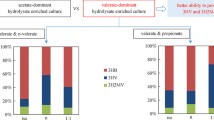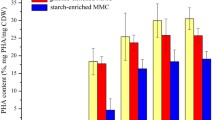Abstract
The feast-to-famine ratio (F/F) represents the extent of selective pressure during polyhydroxyalkanoate (PHA) culture selection. This study evaluated the effects of F/F on a new PHA production system by an enriched culture with valerate-dominant sludge hydrolysate and selected the optimal F/F. After the original F/F 1/3 was modified to 1/1, 1/2, 1/4, and 1/5, F/F did not affect their lengths of feast phase, but affected their biomass growth behaviors during the famine phase and PHA-producing abilities. The optimal F/F was 1/2, and compared with 1/3, it increased the maximal PHA content and the fraction of 3-hydroxyvalerate (3HV) and 3-hydroxy-2-methylvalerate (3H2MV) monomers, with higher productivity and better polymer properties. Although F/F 1/2 impaired the advantage of the dominant genus Delftia, it improved the PHA production rate while decreased biomass growth rate, meanwhile enhancing the utilization and conversion of valerate. These findings indicate that in contrast to previous studies using acetate-dominant substrate for PHA production, the new system fed by valerate-dominant substrate can adopt a higher F/F.




Similar content being viewed by others
References
Albuquerque MGE, Concas S, Bengtsson S, Reis MAM (2010a) Mixed culture polyhydroxyalkanoates production from sugar molasses: the use of a 2-stage CSTR system for culture selection. Bioresour Technol 101(18):7112–7122. https://doi.org/10.1016/j.biortech.2010.04.019
Albuquerque MGE, Torres C, Reis MAM (2010b) Polyhydroxyalkanoate (PHA) production by a mixed microbial culture using sugar molasses: effect of the influent substrate concentration on culture selection. Water Res 44(11):3419–3433. https://doi.org/10.1016/j.watres.2010.03.021
American Public Health Association, American Water Works Association, Water Environment Federation (1995) Standard methods for the examination of water and wastewater, 19th ed. Washington, DC
Beccari M, Majone M, Massanisso P, Ramadori R (1998) A bulking sludge with high storage response selected under intermittent feeding. Water Res 32(11):3403–3413. https://doi.org/10.1016/S0043-1354(98)00100-6
Bengtsson S, Werker A, Christensson M, Welander T (2008) Production of polyhydroxyalkanoates by activated sludge treating a paper mill wastewater. Bioresour Technol 99(3):509–516. https://doi.org/10.1016/j.biortech.2007.01.020
Bhubalan K, Lee WH, Loo CY, Yamamoto T, Tsuge T, Doi Y, Sudesh K (2008) Controlled biosynthesis and characterization of poly (3-hydroxybutyrate-co-3-hydroxyvalerate-co-3-hydroxyhexanoate) from mixtures of palm kernel oil and 3HV-precursors. Polym Degrad Stab 93(1):17–23. https://doi.org/10.1016/j.polymdegradstab.2007.11.004
Campanari S, Augelletti F, Rossetti S, Sciubba F, Villano M, Majone M (2017) Enhancing a multi-stage process for olive oil mill wastewater valorization towards polyhydroxyalkanoates and biogas production. Chem Eng J 317:280–289. https://doi.org/10.1016/j.cej.2017.02.094
Chang HF, Chang WC, Tsai CY (2012) Synthesis of poly (3-hydroxybutyrate/3-hydroxyvalerate) from propionate-fed activated sludge under various carbon sources. Bioresour Technol 113:51–57. https://doi.org/10.1016/j.biortech.2011.12.138
Chen Z, Huang L, Wen Q, Zhang H, Guo Z (2017) Effects of sludge retention time, carbon and initial biomass concentrations on selection process: from activated sludge to polyhydroxyalkanoate accumulating cultures. J Environ Sci 52:76–84. https://doi.org/10.1016/j.jes.2016.03.014
Cui YW, Zhang HY, Lu PF, Peng YZ (2016) Effects of carbon sources on the enrichment of halophilic polyhydroxyalkanoate-storing mixed microbial culture in an aerobic dynamic feeding process. Sci Rep 6(1):30766. https://doi.org/10.1038/srep30766
de Koning G, Kellerhals M, van Meurs C, Witholt B (1997) A process for the recovery of poly (hydroxyalkanoates) from Pseudomonads part 2: process development and economic evaluation. Bioprocess Eng 17(1):15–21. https://doi.org/10.1007/s004490050346
Dionisi D, Beccari M, Gregorio SD, Majone M, Papini MP, Vallini G (2005) Storage of biodegradable polymers by an enriched microbial community in a sequencing batch reactor operated at high organic load rate. J Chem Technol Biotechnol 80(11):1306–1318. https://doi.org/10.1002/jctb.1331
Dionisi D, Majone M, Vallini G, Gregorio SD, Beccari M (2006) Effect of the applied organic load rate on biodegradable polymer production by mixed microbial cultures in a sequencing batch reactor. Biotechnol Bioeng 93(1):76–88. https://doi.org/10.1002/bit.20683
Dionisi D, Majone M, Vallini G, Gregorio SD, Beccari M (2007) Effect of the length of the cycle on biodegradable polymer production and microbial community selection in a sequencing batch reactor. Biotechnol Prog 23(5):1064–1073. https://doi.org/10.1021/bp060370c
Doi Y, Kunioka M, Nakamura Y, Soga K (1986) Nuclear magnetic resonance studies on poly (β-hydroxybutyrate) and a copolyester of β-hydroxybutyrate and β-hydroxyvalerate isolated from Alcaligenes eutrophus H16. Macromolecules 19(11):2860–2864. https://doi.org/10.1021/ma00165a033
Fernández-Dacosta C, Posada JA, Kleerebezem R, Cuellar MC, Ramirez A (2015) Microbial community-based polyhydroxyalkanoates (PHAs) production from wastewater: techno-economic analysis and ex-ante environmental assessment. Bioresour Technol 185:368–377. https://doi.org/10.1016/j.biortech.2015.03.025
Hanson AJ, Guho NM, Paszczynski AJ, Coats ER (2016) Community proteomics provides functional insight into polyhydroxyalkanoate production by a mixed microbial culture cultivated on fermented dairy manure. Appl Microbiol Biotechnol 100(18):7957–7976. https://doi.org/10.1007/s00253-016-7576-7
Hao J, Wang H (2015) Volatile fatty acids productions by mesophilic and thermophilic sludge fermentation: biological responses to fermentation temperature. Bioresour Technol 175:367–373. https://doi.org/10.1016/j.biortech.2014.10.106
Hao J, Wang X, Wang H (2017a) Investigation of polyhydroxyalkanoates (PHAs) biosynthesis from mixed culture enriched by valerate-dominant hydrolysate. Front Environ Sci Eng 11(1):5. https://doi.org/10.1007/s11783-017-0896-8
Hao J, Wang X, Wang H (2017b) Overall process of using a valerate-dominant sludge hydrolysate to produce high-quality polyhydroxyalkanoates (PHA) in a mixed culture. Sci Rep 7(1):6939. https://doi.org/10.1038/s41598-017-07154-3
Huang L, Chen Z, Wen Q, Lee DJ (2017) Enhanced polyhydroxyalkanoate production by mixed microbial culture with extended cultivation strategy. Bioresour Technol 241:802–811. https://doi.org/10.1016/j.biortech.2017.05.192
Jia Q, Wang H, Wang X (2013) Dynamic synthesis of polyhydroxyalkanoates by bacterial consortium from simulated excess sludge fermentation liquid. Bioresour Technol 140:328–336. https://doi.org/10.1016/j.biortech.2013.04.105
Jiang Y, Sorokin DY, Kleerebezem R, Muyzer G, van Loosdrecht MCM (2011) Plasticicumulans acidivorans gen. nov., sp. nov., a polyhydroxyalkanoate-accumulating gammaproteobacterium from a sequencing-batch bioreactor. Int J Syst Evol Microbiol 61(9):2314–2319. https://doi.org/10.1099/ijs.0.021410-0
Kranz RG, Gabbert KK, Locke TA, Madigan MT (1997) Polyhydroxyalkanoate production in Rhodobacter capsulatus: genes, mutants, expression, and physiology. Appl Environ Microbiol 63(8):3003–3009
Lee WH, Loo CY, Nomura CT, Sudesh K (2008) Biosynthesis of polyhydroxyalkanoate copolymers from mixtures of plant oils and 3-hydroxyvalerate precursors. Bioresour Technol 99(15):6844–6851. https://doi.org/10.1016/j.biortech.2008.01.051
Lemos P, Levantesi C, Serafim L, Rossetti S, Reis MM, Tandoi V (2008) Microbial characterisation of polyhydroxyalkanoates storing populations selected under different operating conditions using a cell-sorting RT-PCR approach. Appl Microbiol Biotechnol 78(2):351–360. https://doi.org/10.1007/s00253-007-1301-5
Loo CY, Sudesh K (2007) Biosynthesis and native granule characteristics of poly (3-hydroxybutyrate-co-3-hydroxyvalerate) in Delftia acidovorans. Int J Biol Macromol 40(5):466–471. https://doi.org/10.1016/j.ijbiomac.2006.11.003
Marang L, van Loosdrecht MCM, Kleerebezem R (2015) Modeling the competition between PHA-producing and non-PHA-producing bacteria in feast-famine SBR and staged CSTR systems. Biotechnol Bioeng 112(12):2475–2484. https://doi.org/10.1002/bit.25674
Michinaka A, Arou J, Onuki M, Satoh H, Mino T (2007) Analysis of polyhydroxyalkanoate (PHA) synthase gene in activated sludge that produces PHA containing 3-hydroxy-2-methylvalerate. Biotechnol Bioeng 96(5):871–880. https://doi.org/10.1002/bit.21085
Mohapatra S, Samantaray DP, Samantaray SM, Mishra BB, Das S, Majumdar S, Pradhan SK, Rath SN, Rath CC, Akthar J, Achary KG (2016) Structural and thermal characterization of PHAs produced by Lysinibacillus sp. through submerged fermentation process. Int J Biol Macromol 93(Pt A):1161–1167. https://doi.org/10.1016/j.ijbiomac.2016.09.077
Morgan-Sagastume F, Karlsson A, Johansson P, Pratt S, Boon N, Lant P, Werker A (2010) Production of polyhydroxyalkanoates in open, mixed cultures from a waste sludge stream containing high levels of soluble organics, nitrogen and phosphorus. Water Res 44(18):5196–5211. https://doi.org/10.1016/j.watres.2010.06.043
Oliveira CS, Silva CE, Carvalho G, Reis MAM (2016) Strategies for efficiently selecting PHA producing mixed microbial cultures using complex feedstocks: feast and famine regime and uncoupled carbon and nitrogen availabilities. New Biotechnol 37(Pt A):69–79. https://doi.org/10.1016/j.nbt.2016.10.008
Philip S, Keshavarz T, Roy I (2007) Polyhydroxyalkanoates: biodegradable polymers with a range of applications. J Chem Technol Biotechnol 82(3):233–247. https://doi.org/10.1002/jctb.1667
Samantaray S, Mallick N (2014) Production of poly (3-hydroxybutyrate-co-3-hydroxyvalerate) co-polymer by the diazotrophic cyanobacterium Aulosira fertilissima CCC 444. J Appl Phycol 26(1):237–245. https://doi.org/10.1007/s10811-013-0073-9
Tao B, Passanha P, Kumi P, Wilson V, Jones D, Esteves S (2016) Recovery and concentration of thermally hydrolysed waste activated sludge derived volatile fatty acids and nutrients by microfiltration, electrodialysis and struvite precipitation for polyhydroxyalkanoates production. Chem Eng J 295:11–19. https://doi.org/10.1016/j.cej.2016.03.036
Valentino F, Brusca AA, Beccari M, Nuzzo A, Zanaroli G, Majone M (2013) Start up of biological sequencing batch reactor (SBR) and short-term biomass acclimation for polyhydroxyalkanoates production. J Chem Technol Biotechnol 88(2):261–270. https://doi.org/10.1002/jctb.3824
Villano M, Lampis S, Valentino F, Vallini G, Majone M, Beccari M (2010) Effect of hydraulic and organic loads in a sequencing batch reactor on microbial ecology of activate sludge and storage of polyhydroxyalkanoates. Chem Eng Trans 20:187–192. https://doi.org/10.3303/CET1020032
Wang X, Oehmen A, Freitas EB, Carvalho G, Reis MAM (2017a) The link of feast-phase dissolved oxygen (DO) with substrate competition and microbial selection in PHA production. Water Res 112:269–278. https://doi.org/10.1016/j.watres.2017.01.064
Wang Y, Zhu Y, Gu P, Li Y, Fan X, Song D, Ji Y, Li Q (2017b) Biosynthesis of poly (3-hydroxybutyrate-co-3-hydroxyvalerate) by bacterial community from propylene oxide saponification wastewater residual sludge. Int J Biol Macromol 98:34–38. https://doi.org/10.1016/j.ijbiomac.2017.01.106
Wu B, Zheng D, Zhou Z, Wang JL, He XL, Li ZW, Yang HN, Qin H, Zhang M, Hu GQ (2017) The enrichment of microbial community for accumulating polyhydroxyalkanoates using propionate-rich waste. Appl Biochem Biotechnol 182(2):755–768. https://doi.org/10.1007/s12010-016-2359-2
Acknowledgements
The authors kindly thank Jian Ma and Chongyang Wang for their valuable help in the periodical sludge sampling.
Funding
This work was supported by the National Key Research Project on Water Environment Pollution Control in China (no. 2012ZX07313-001) and the Tsinghua University Initiative Scientific Research Program (no. 20101081834, 20121087922).
Author information
Authors and Affiliations
Corresponding author
Ethics declarations
Conflict of interest
The authors declare that they have no conflict of interest.
Ethical approval
This article does not contain any studies with human participants or animals performed by any of the authors.
Electronic supplementary material
ESM 1
(PDF 282kb)
Rights and permissions
About this article
Cite this article
Hao, J., Wang, H. & Wang, X. Selecting optimal feast-to-famine ratio for a new polyhydroxyalkanoate (PHA) production system fed by valerate-dominant sludge hydrolysate. Appl Microbiol Biotechnol 102, 3133–3143 (2018). https://doi.org/10.1007/s00253-018-8799-6
Received:
Revised:
Accepted:
Published:
Issue Date:
DOI: https://doi.org/10.1007/s00253-018-8799-6




